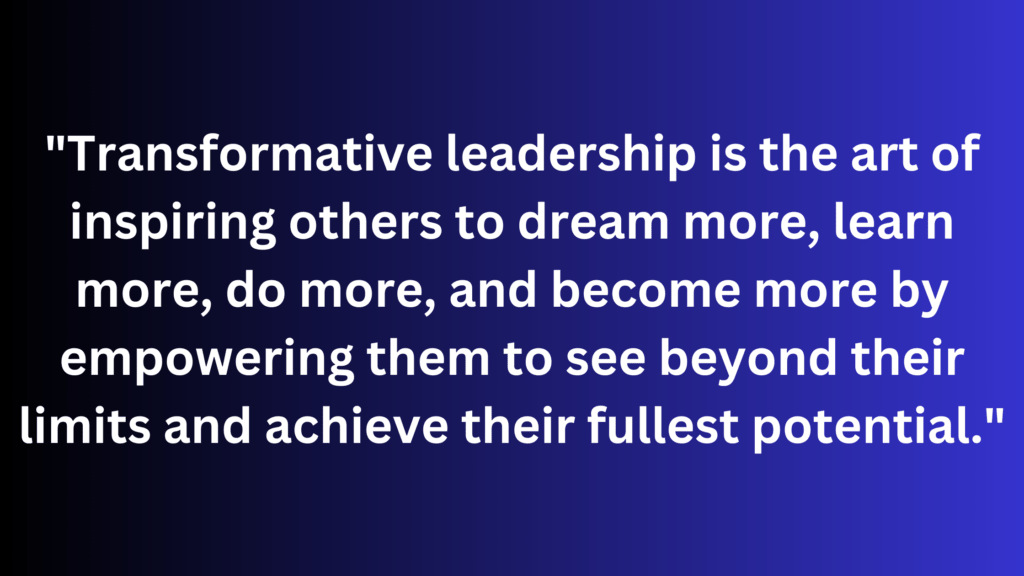Introduction
The Essence of Transformative Leadership
Transformative leadership is more than a management style; it’s a philosophy that fosters an environment where team members feel inspired and empowered to achieve their fullest potential. This leadership approach emphasizes vision, trust, and the development of a positive organizational culture.
Why Inspiration and Empowerment Matter
Inspiration and empowerment are crucial for team success. Inspired teams are more motivated, creative, and productive. Empowered individuals take ownership of their work, leading to higher levels of innovation and job satisfaction. Together, these elements create a robust and dynamic workforce.
Understanding Transformative Leadership

Definition and Core Principles
Transformative leadership involves guiding a team towards a shared vision while promoting individual growth and development. Core principles include authenticity, empathy, and a commitment to continuous improvement.
The Distinction Between Traditional and Transformative Leadership
Unlike traditional leadership, which often focuses on hierarchy and control, transformative leadership emphasizes collaboration and empowerment. This approach nurtures a more engaged and motivated team.
The Power of Vision
Crafting a Compelling Vision
A compelling vision acts as a beacon, guiding the team towards a common goal. It’s essential to articulate a clear, inspiring vision that aligns with the values and aspirations of both the organization and its members.
Communicating the Vision Effectively
Effective communication is vital to ensure the vision resonates with the team. This involves regular updates, transparent discussions, and ensuring everyone understands their role in achieving the vision.
Building Trust and Credibility
The Role of Authenticity
Authenticity builds trust. Leaders who are genuine and transparent foster an environment where team members feel safe to express their ideas and concerns.
Consistency and Integrity
Consistency in actions and decisions strengthens credibility. Integrity means keeping promises and standing by your values, which in turn, builds a foundation of trust within the team.
Cultivating a Positive Work Environment
Fostering Open Communication
Open communication is the bedrock of a positive work environment. Encourage team members to share their thoughts, provide feedback, and engage in meaningful dialogue.
Encouraging Collaboration and Innovation
A collaborative environment nurtures innovation. By breaking down silos and encouraging teamwork, leaders can harness the collective creativity of their teams to drive innovation.
Empowering Through Delegation
The Art of Effective Delegation
Delegation is not just about distributing tasks; it’s about empowering team members by entrusting them with responsibility. Effective delegation involves clear instructions, the right level of autonomy, and support when needed.
Trusting Your Team’s Abilities
Trust is crucial in delegation. Believe in your team’s capabilities and provide them with the resources and confidence to succeed. This trust encourages initiative and ownership.
Encouraging Personal and Professional Growth
Providing Opportunities for Development
Investing in team development pays dividends. Offer training, workshops, and opportunities for learning to help team members grow both personally and professionally.
Mentoring and Coaching
Mentorship and coaching are powerful tools for development. Providing guidance, sharing experiences, and offering constructive feedback can significantly impact an individual’s growth trajectory.
Recognizing and Celebrating Achievements
The Impact of Positive Reinforcement
Recognition boosts morale and motivation. Celebrate successes, big and small, to reinforce positive behavior and achievements.
Implementing Reward Systems
Reward systems can range from formal awards to informal acknowledgments. Tailor rewards to what is meaningful to your team to maximize their impact.
Leading by Example
Demonstrating Commitment and Passion
Leadership by example means showing the dedication and enthusiasm you expect from your team. Your behavior sets the standard and inspires others to follow suit.
The Importance of Leading from the Front
Leading from the front involves being actively involved and visible in the team’s efforts. This approach builds respect and encourages team members to emulate your commitment.
Embracing Change and Flexibility
Navigating Organizational Change
Change is inevitable. Effective leaders guide their teams through change by being adaptable, supportive, and maintaining a positive outlook.
Adapting Leadership Styles to Suit Different Situations
Different situations require different leadership styles. Flexibility in approach ensures that you can meet the unique needs of each scenario and team member.
Enhancing Emotional Intelligence
Understanding and Managing Emotions
Emotional intelligence is critical for effective leadership. Recognize and manage your emotions, and understand the emotions of your team to foster a supportive environment.
Building Empathy and Compassion
Empathy and compassion build strong relationships. By understanding and addressing the emotional needs of your team, you create a more cohesive and motivated workforce.
Encouraging Ownership and Accountability
Creating a Sense of Responsibility
Encourage a sense of ownership by involving team members in decision-making and giving them autonomy in their roles. This responsibility fosters accountability and pride in their work.
Holding the Team Accountable
Accountability ensures that team members follow through on their commitments. Set clear expectations and provide the necessary support to meet them.
Fostering a Culture of Continuous Improvement
Implementing Feedback Loops
Continuous improvement relies on regular feedback. Create a culture where feedback is constructive, frequent, and valued as a tool for growth.
Encouraging Innovation and Creativity
Innovation thrives in a supportive environment. Encourage your team to think creatively, experiment, and learn from their experiences.
Leveraging Technology for Empowerment
Utilizing Digital Tools for Collaboration
Digital tools can enhance collaboration and efficiency. Implement platforms that facilitate communication, project management, and knowledge sharing.
Embracing Remote Work and Virtual Teams
Remote work and virtual teams are becoming the norm. Embrace this shift by providing the necessary technology and support to ensure your team remains connected and productive.
Conclusion
Recapitulating Transformative Leadership Secrets
Transformative leadership is about inspiring and empowering your team through vision, trust, and development. By embracing these principles, leaders can create a thriving, motivated workforce.
The Long-term Impact of Empowering Leadership
Empowering leadership not only drives immediate results but also fosters long-term success. A motivated, engaged team is more likely to innovate, adapt, and excel, ensuring sustained growth and achievement.
For more content follow Humstory.













